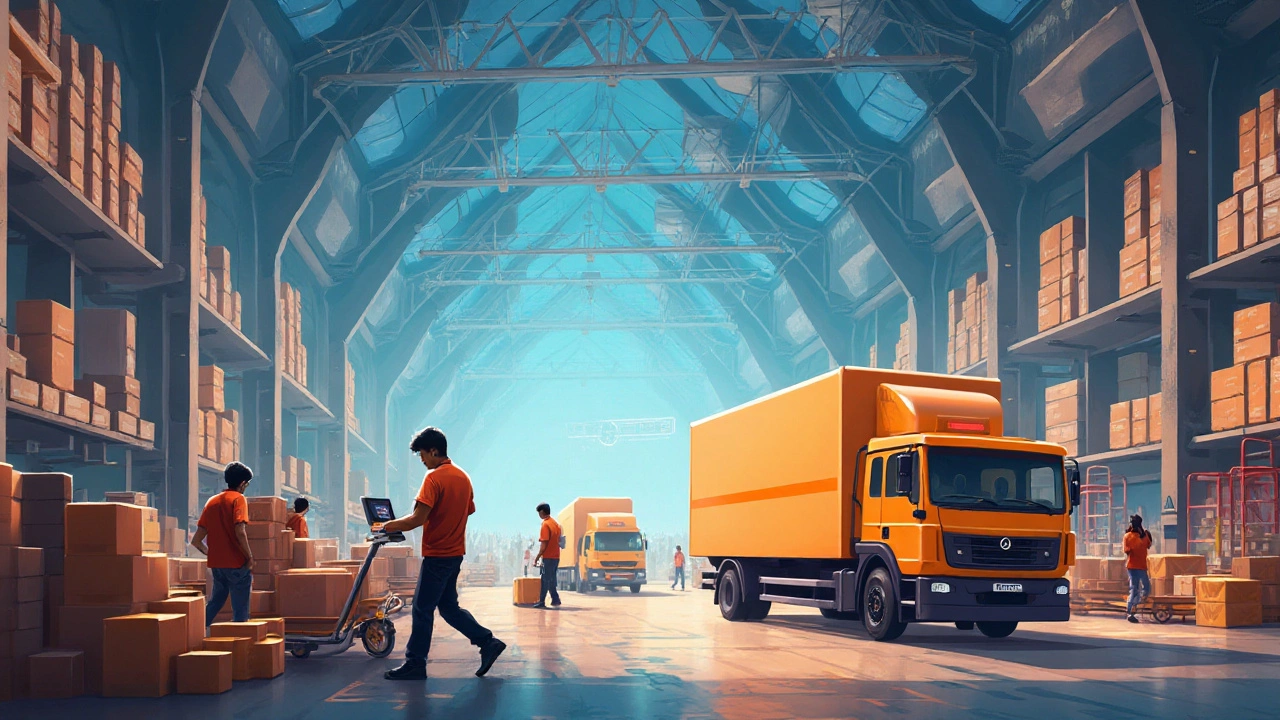In an age where digital influences nearly every aspect of our lives, logistics has not been left untouched. As e-commerce continues to surge, so does the need for an evolution in the way goods are stored, managed, and delivered. Enter e-logistics—a sophisticated, tech-driven approach that promises to elevate traditional logistics practices.
Determining the differences between traditional logistics and e-logistics can empower businesses to make strategic decisions that optimize their operations. Today's fast-paced market demands efficiency paired with the flexibility to meet consumer needs. As we navigate through these contrasts, we throw light on how embracing technological advancements can transform logistics into a competitive advantage.
- Definition and Scope
- Technological Integration
- Cost and Efficiency
- Customer Experience
- Challenges and Solutions
- Future Trends
Definition and Scope
The world of logistics is vast, encompassing a broad range of activities essential for the management of the flow of goods from point of origin to point of consumption. Traditional logistics primarily involves the physical planning, implementation, and control of these flows. It focuses on warehousing, transportation, inventory management, and demand planning—all aiming at maximizing efficiency and cost-effectiveness in a tangible environment. Typically, it deals with bulk shipping, often oriented towards retail and wholesale industries, relying heavily on manual processes.
On the other side, e-logistics emerges as the backbone of today's thriving e-commerce sector. It’s a technology-influenced adaptation of logistics tailored to meet the requirements of online marketplaces. As e-commerce blossoms, there’s a direct transition towards integrating digital tools like real-time tracking, automated warehouses, and data analytics. E-logistics offers a comprehensive approach with greater transparency, agility, and scalability to meet consumer demands with heightened precision. This modern form of logistics supports a more segmented and small-batch delivery structure and is built on a platform of information technology.
"The transformative impact of e-logistics is evident in our ability to meet increasingly specific customer demands with speed and accuracy," said John Smith, a logistics expert from the E-Commerce Warehouse Institute, highlighting the shift towards technology-centric practices. In essence, e-logistics empowers businesses with immediate data analysis and predictive capabilities, enhancing decision-making processes and offering a competitive edge.
The scope of logistics under the traditional model often had geographical and scale limitations. Companies primarily focused on local or regional markets. However, entering the realm of e-logistics means breaking through geographical boundaries. Companies can now operate on a global scale with an interconnected grid of digital communication and cloud-based platforms. Whether it means using AI to anticipate market trends or employing drones for last-mile deliveries, the playing field is continuously evolving. The integration of such innovations not only drives a more efficient supply chain but also revolutionizes customer experience by ensuring rapid and reliable delivery.
As the industry advances, the dichotomy between traditional logistics and e-logistics sheds light on their distinct scopes. While traditional logistics serves as the foundation of movement, storage, and flow of goods, e-logistics repurposes it with technological enhancements aimed at acing the dynamic expectations of the modern consumer. Thus, what started as ladder climbing—securing places brick by brick—has now turned into transcending digital landscapes, paving the way for smarter, leaner, and more responsive logistics.
Technological Integration
The era of e-logistics is unmistakably defined by the strategic use of technology. At its core, technological integration distinguishes e-logistics from its traditional counterpart by leveraging advanced tools to optimize supply chain processes and enhance service delivery. Unlike traditional logistics, which often relies heavily on manual processes and human intervention, e-logistics employs automation to streamline operations, reduce errors, and accelerate delivery times. Through the use of IoT (Internet of Things) devices, real-time tracking and monitoring of shipments have become standard practice, offering unprecedented transparency to both retailers and consumers.
Modern logistics software has revolutionized inventory management. By utilizing AI and machine learning algorithms, e-logistics systems can predict demand with remarkable accuracy, ensuring that stock levels are consistently aligned with customer needs. This technological foresight not only minimizes the risk of overstocking or stockouts but also significantly reduces storage costs, thereby boosting efficiency and profitability for businesses involved in e-commerce. Integrating technology into logistics equates to enhanced data analytics capability, providing insights into consumer behavior, shipping trends, and cost-saving opportunities. These analytics enable businesses to tailor their strategies to improve performance and customer satisfaction.
Moreover, the shift towards cloud-based platforms has simplified the management of logistics operations. Companies now benefit from scalable, flexible solutions that allow for seamless collaboration across different geographical locations. Through centralized data systems, communication barriers are dismantled, fostering more agile and responsive supply chains. According to a report by McKinsey, companies that have embraced digital logistics practices are witnessing a 10-20% reduction in overall logistics costs and a 20-30% enhancement in service levels. This data reflects the undeniable impact of technological integration on operational success.
"The future of logistics is digital. Companies that embrace technology will not only survive but thrive in the competitive landscape." - Boston Consulting Group
An important component of technological integration in e-logistics is the use of blockchain technology, which ensures the security and integrity of transactions. By providing a decentralized, immutable ledger, blockchain minimizes the risk of fraud and increases trust among parties involved in the supply chain. The application of blockchain in logistics enhances transparency, simplifying the traceability of products and materials from origin to customer. Digital twins, another innovative technology, allows companies to create virtual replicas of physical logistics processes. This technology aids in identifying potential issues before they manifest, thus enabling proactive solutions and maintaining seamless operations. Its application in logistics offers an effective means to visualize, model, and optimize workflow efficiency.
The impact of technological integration in logistics also extends to environmental sustainability. Advanced route optimization algorithms and smart transportation systems reduce fuel consumption, thereby lowering carbon emissions. As businesses become increasingly mindful of their environmental footprint, integrating sustainable practices through technology becomes a pivotal priority. This shift not only aligns with corporate social responsibility goals but also meets the growing consumer demand for eco-friendly practices within the e-commerce domain.

Cost and Efficiency
When considering the logistics landscape, discussions about cost and efficiency inevitably take center stage. In the realm of traditional logistics, the approach often involves bulk shipments, pre-set schedules, and geographically fixed distributions centers which are all designed to minimize costs through economies of scale. However, this model may lack the agility required in today's fast-paced e-commerce environment. On the other hand, e-logistics leverages cutting-edge technology to streamline processes and reduce expenses by optimizing routes, minimizing delays, and utilizing real-time data analytics. This transformation aims to cater to the increasing demand for speedy deliveries and high-quality service which are pivotal in retaining customer loyalty.
The intersection of technology with logistics has revolutionized the way businesses handle inventory and fulfill orders. Companies adopting e-logistics solutions often find themselves benefiting from automated warehouses where robotics and IoT devices play key roles. Automated sorting and handling can significantly decrease the need for manual labor, ultimately reducing human error and operational costs. Additionally, e-logistics platforms typically offer more efficient route planning and tracking capabilities, leveraging algorithms that consider traffic patterns and weather conditions. This can lead to reduced delivery times and increased fuel efficiency, squeezing savings out of every mile driven.
It's fascinating to observe how economies of scale are being challenged by economies of scope in e-commerce. E-logistics places a premium on flexibility and customization, allowing businesses to tailor their delivery models according to consumer demands rather than sticking to rigid pre-defined frameworks. Companies can experiment with different delivery windows, package sizes, and even personalized customer interactions, ultimately optimizing their processes to deliver the greatest value at the lowest cost. A study by the Global Supply Chain Institute highlighted that companies investing in digital logistics solutions saw an average reduction in order-to-delivery cycles of up to 67%.
However, it's not merely cost reductions that make e-logistics attractive—it's the ability to achieve these savings while simultaneously maintaining or even enhancing service quality. Consider the impact of predictive analytics and AI on this domain. By using predictive models, companies can forecast demand surges, optimize inventory levels, and improve their strategic planning for peaks in consumer activity. This proactive approach reduces the likelihood of stockouts and excess inventory, which are common budget drainers in any supply chain. Enhanced consumer satisfaction is frequently observed as a by-product of improved accuracy and reduced waiting times.
"E-logistics is not just a system, it's a philosophy of efficiency that redefines convenience," noted Claire Haskett, a leading analyst at TechLog Consulting.
That said, the transition from traditional logistics to e-logistics is not devoid of challenges. Initial investments in technology can be high, and the implementation period may disrupt existing operations. As companies weigh these dynamics, it's important they conduct a thorough cost-benefit analysis. Many businesses find that the long-term advantages of improved efficiency, customer satisfaction, and competitive edge outweigh the short-term transitional costs. Supply chain resilience built on digital innovation is quickly becoming non-negotiable in the modern market, setting leaders apart from laggards.
Customer Experience
In the realm of e-commerce, providing a stellar customer experience is more than just a buzzword—it's a business imperative. The evolution of logistic operations from traditional to e-logistics is at the forefront of this transformation. Customer expectations are constantly rising, and e-logistics is designed to meet and exceed these demands by leveraging advanced technology. With the advent of real-time tracking systems, the customer is no longer left guessing about the fate of their purchase. From the moment an order is placed, every touchpoint can be monitored, offering a level of transparency that was unthinkable in the days of traditional logistics.
One of the significant advantages of e-logistics is the seamless experience it offers. The integration of chatbots and AI-driven customer service tools allows for instantaneous assistance, addressing concerns or queries swiftly, often before a customer feels the need to ask. This proactive approach not only boosts customer satisfaction but also encourages brand loyalty. Moreover, the agility of e-logistics systems enables personalized delivery choices, like same-day shipping or specific time windows, which can cater even to the most demanding schedules.
The impact of this on customer experience is profound. According to a survey conducted by a leading market research firm, 73% of online shoppers consider delivery experience a vital part of their purchasing decision. As such, logistics companies investing in e-logistics are several steps ahead in capturing consumer trust. An interesting trend seen in recent years is the rise of environmentally conscious consumers who are choosing brands based on sustainable practices, including green logistics. Traditional logistics struggles to match up to these advanced service levels, often due to a lack of flexibility and outdated technology.
"Modern customers don't just care about the products they buy—they care deeply about the experience surrounding those purchases," remarked John Smith, an expert in supply chain management.
It's not just speed and convenience that make a difference, but also reliability. E-logistics systems are equipped with predictive analytics to preempt potential delays and reroute shipments efficiently. If the unexpected does occur, customers are kept in the loop with immediate updates, turning a possible frustration into a testament of commitment to service. Brands utilizing these systems have seen a significant dip in return rates, reflecting increased first-time satisfaction. In essence, e-logistics is an enabler of customer-centric strategies, reshaping the traditional supply chain's focus from operations-first to customer-first.

Challenges and Solutions
The transition from traditional logistics to e-logistics presents several challenges that businesses must overcome to thrive in the competitive landscape of e-commerce. One pressing issue is the integration of advanced technology into existing operations. Many companies with established systems find it daunting to implement new technologies like AI and IoT. These technologies are crucial, however, to optimizing supply chain management and achieving greater efficiency. Successful integration requires a well-thought-out strategy that includes employee training and the gradual implementation of tech solutions.
The Technological Divide
Another significant challenge is the technological divide that separates different businesses. Smaller companies often lack the resources to adopt new logistics technologies as quickly as their larger counterparts. This gap can lead to disparities in performance and customer satisfaction. Companies can overcome this hurdle by leveraging third-party logistics service providers that offer scalable solutions tailored to different business sizes.
"As technology progresses, the key to transforming our supply chains lies in our ability to embrace change." - Adrian Gonzalez, Supply Chain Expert
Ensuring real-time visibility is also a major challenge. In traditional logistics, updates on shipment status could be delayed, leading to misinformation and customer dissatisfaction. E-logistics strives to overcome this by utilizing sophisticated tracking technologies that provide real-time updates. Businesses can use GPS, RFID, and blockchain to improve transparency and ensure customers are kept informed every step of the way.
Cost Management
Cost management is another area where companies struggle when shifting to e-logistics. The initial investment for technology upgrades and system integration can be substantial, but businesses must view this as a long-term investment. Implementing automated solutions reduces labor costs and increases efficiency. By conducting a thorough cost-benefit analysis, companies can ensure their investments in e-logistics yield significant returns over time.
Moreover, developing strategic partnerships and alliances can serve as a useful solution to many logistical challenges. Sharing resources and expertise with other companies can result in mutually beneficial arrangements. A great example is the trend of businesses in the same industry cooperating on last-mile delivery solutions to cut down costs and improve efficiency.
Security Concerns
Data security is a critical aspect that requires attention. As e-logistics solutions rely heavily on data, protecting this information from potential breaches is crucial. Companies must invest in robust cybersecurity measures and regular audits to guard against any vulnerabilities. Using secure platforms and implementing strict compliance protocols helps in maintaining the trust that customers expect.
Ultimately, while challenges abound in the shift from traditional to e-logistics, the solutions are within reach. By staying informed, planning strategically, and embracing innovations, companies can navigate these complexities and position themselves for success in the evolving e-commerce landscape.
Future Trends
The landscape of logistics is at the cusp of significant changes, and several trends are poised to reshape the field in the coming years. One of the most pronounced shifts is the increasing deployment of e-logistics solutions. As companies strive to improve efficiency and customer satisfaction in their supply chains, technological advancements lie at the heart of this transformation. The adoption of artificial intelligence and machine learning, for instance, is enabling predictive analytics. This helps businesses anticipate demand surges and mitigate potential disruptions before they affect operations.
In addition to AI, the integration of the Internet of Things (IoT) devices in logistics processes is becoming more prevalent. IoT technology facilitates real-time tracking of goods and assets, providing unparalleled transparency across the entire supply chain. This level of visibility empowers companies with actionable insights, leading to informed decision-making and enhanced operational efficiency. It is also significantly contributing to the reduction of waste, which aligns with the growing emphasis on sustainability in logistics practices.
An exciting development in the sector is the rise of autonomous delivery vehicles and drones. While still in its nascent stages, autonomous delivery offers a glimpse into a more agile and cost-effective means of getting goods to consumers. Several industry leaders are investing in this technology, seeing it as a solution to logistical bottlenecks and labor shortages. According to a report from McKinsey, "autonomous vehicles could cut last-mile delivery costs by up to 40%". This underscores the potential of automated logistics solutions in ushering a new era of cost-effective supply chains.
Robotics is also making inroads into warehousing and distribution centers. Automated warehouse systems, equipped with robots for picking, sorting, and packaging, are becoming the norm rather than the exception. These systems not only enhance accuracy but also dramatically speed up processes, thereby reducing delivery times. With e-commerce continuing to burgeon, the demand for such efficiencies is set to grow exponentially in the future.
To amplify the impact of emerging technologies, many businesses are placing greater focus on data analytics and integration. Unified platforms that bring together disparate logistics systems enable better coordination and communication between stakeholders. This trend towards digital ecosystems is pivotal in creating seamless operations spanning from suppliers to customers. As logistics services become increasingly interlinked, the role of data analytics in driving strategic insights and value cannot be overstated.
Moreover, sustainability is climbing the ranks of priority in logistics strategies. Consumers' increasing awareness and demand for green practices compel companies to integrate more eco-friendly methods in their operations. Electric vehicles, biofuels, and route optimization algorithms are just a few of the innovations contributing to this green shift. Expectations for companies to not only adapt but also champion sustainability initiatives are set to increase, making environmental stewardship a critical component of future logistics strategies.





